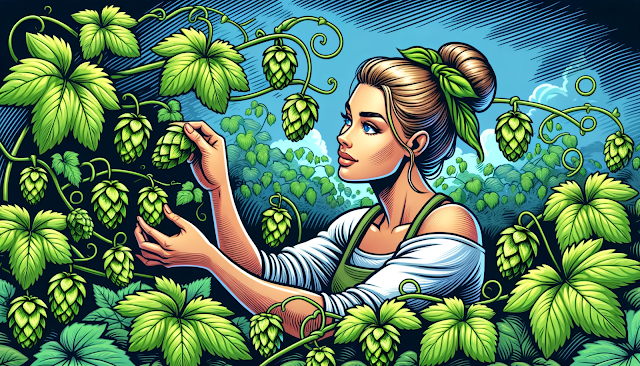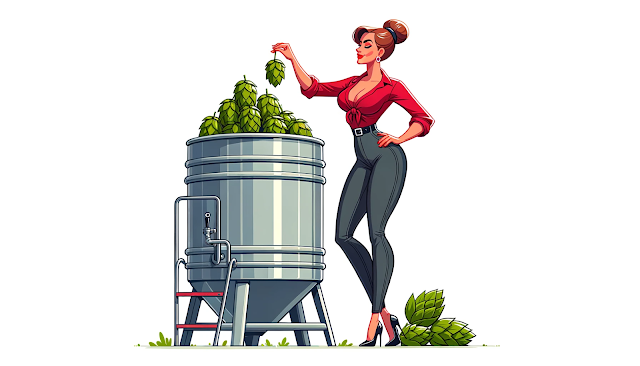Beer has been a beloved beverage for centuries, with its roots tracing back to ancient civilizations.
While the art of brewing has evolved and seen myriad innovations, the fundamental principles remain constant. Regardless of the year or the brewing method, the goal is simple: produce the best quality beer. In the modern era, beer kits have emerged as a convenient alternative to traditional brewing, often facing undue criticism.
However, contrary to the naysayers, beer kits offer both novices and veterans a chance to craft delightful brews. This guide is a testament to that potential, offering timeless advice to elevate your homebrewing experience.
 |
| Even super men clean their brewing equipment! |
The Essence of Cleanliness
The Timeless Importance of a Clean Brew: No matter the decade, cleanliness remains at the heart of brewing. From ancient brewers to modern-day enthusiasts, ensuring that the brewing equipment is pristine has always been paramount. Your chosen beer kit sets the stage, but before diving into brewing, the golden rule is 'Keep it Clean.'
Sanitization and Modern Cleaning Agents: Enter sodium percarbonate, a modern cleaning agent that's likely already in your laundry room. While our brewing ancestors might not have had access to such agents, we do, and it's essential to leverage them. A clean fermenter ensures that the flavors of your beer remain untainted and true to your intentions.
Learning from Mistakes: Personal experiences often serve as the best lessons. Neglecting cleanliness can lead to infected brews, wasting not just ingredients but also effort. Remember, while shortcuts might seem tempting, they often come at the cost of your whole beer batch when that pesky bacteria sets in.
\
Mastering the Art of Temperature
Fermentation's Fickle Nature: One of the pivotal stages of brewing, fermentation is heavily influenced by temperature. While the process might seem forgiving, even slight temperature deviations can dramatically alter the outcome.
Temperature Guidelines for Different Brews: Lagers and ales, though both beers, have distinct temperature needs. Lagers thrive between 10-14 degrees, while ales prefer the warmth of 18-21 degrees. It's essential to tailor your brewing environment accordingly.
Consistency is Key: Fluctuating temperatures can stress the yeast, leading to unwanted flavors in the beer. Maintaining a stable temperature environment, perhaps with the aid of blankets or temperature-controlled rooms, can significantly enhance the quality of your brew.

Patience: The Brewer's Virtue
Brewing is not a race; it's a journey. The wort, which serves as the foundation for your beer, typically takes about a week to ferment. However, gauging fermentation's completion isn't just about time—it's about observation.
Hydrometer: The Brewer's Best Friend: This simple tool can be a game-changer. By taking consistent readings over several days, you can ascertain when fermentation has concluded. When consecutive readings remain unchanged, it's a clear indication that fermentation has likely finished.
Beyond Fermentation: Once fermentation appears complete, resist the urge to bottle immediately. Give your brew an additional week. During this time, the yeast continues its work, refining the beer, enhancing clarity, and ensuring a cleaner taste profile.
Hops: Elevating the Beer Experience
While a combination of malt, sugar, and yeast can produce a beer, it's the addition of hops that transforms it into BEER! Hops introduce a range of flavors and aromas, adding depth and character to the brew.
Choosing the Right Hops: With countless hop varieties available, selecting the right one can feel daunting. However, centuries of brewing have yielded some tried-and-true hop combinations. Familiarizing oneself with these can guide brewers in making informed choices.
For those keen on exploring the world of hops further, there are comprehensive guides that delve into the nuances of each variety, helping brewers match hops to their desired beer style and flavor profile.
Want Clearer Beer?
Clarity in beer isn't just about aesthetics; it often signifies a well-brewed beverage. Enter fining agents, like gelatin, which bind to particulates in the beer, causing them to settle at the bottom of the fermenter.Timing and Technique: While gelatin can be added at any stage post-fermentation, it's most effective when introduced to cooler beer, ideally a few days before bottling. This ensures optimal clarity without affecting flavor.
A Note on Vegan Brewing: It's worth noting that traditional gelatin is derived from animal sources, rendering the beer unsuitable for vegans. Brewers catering to a vegan audience should explore alternative fining agents that align with vegan principles.

Clarity is King: Achieving Crystal-Clear Beer
Unveiling the Secrets of Clear Beer: Clarity in beer is more than just a visual delight; it's a hallmark of a well-executed brew. While the brewing process inherently introduces particles and haze, achieving that crystal-clear appearance is within every brewer's reach.
Gelatin: The Brewer's Clarifying Agent: One of the most effective fining agents, gelatin works by binding to the residual particles in the beer. As these gelatin-particle complexes become heavier, they settle to the bottom, leaving behind clear beer. To maximize its effectiveness, introduce gelatin to a cooler beer, preferably a couple of days before bottling.
Vegan Concerns and Alternatives: Traditional gelatin has animal origins, making the end product unsuitable for vegans. If catering to a vegan audience, or if you're vegan yourself, explore plant-based alternatives that offer similar clarifying properties without compromising on ethics.
Exploring the World of Yeast
While hops and malt often steal the limelight, yeast is the silent workhorse of brewing. It's responsible for fermentation, transforming sugars into alcohol and imparting unique flavor profiles to the beer.
Venturing Beyond Kit Yeast: Beer kits typically come with a standard yeast, which, while reliable, might not always offer the desired flavor nuances. For those looking to elevate their lagers, consider exploring specialized yeasts, such as Safale, renowned in the brewing community for its exceptional lager-producing capabilities.
Experimentation is Key: The world of yeast is vast, with each strain offering distinct characteristics. Don't hesitate to experiment. Changing the yeast can transform a familiar beer kit into a new and exciting brew.

Sweet Success: Mastering Priming Sugar
The delightful fizziness in beer—is achieved through priming sugar. Added before bottling, this sugar undergoes fermentation, producing carbon dioxide, which carbonates the beer.
Striking the Right Balance: While carbonation enhances the beer-drinking experience, over-carbonation can lead to "gushers"—bottles that overflow upon opening. Achieving the right balance requires precision. Measure the priming sugar carefully, and consider using carbonation drops for consistent results.
Chill Before You Thrill: Before popping open a bottle, give it a good chill. Not only does this enhance the beer's flavor, but it also helps manage carbonation, reducing the risk of over-fizziness, especially in over-primed batches.
Oxygen: A Double-Edged Sword in Brewing
Oxygen's Role in Beer: While oxygen is essential during the early stages of brewing, especially for yeast health, its presence post-fermentation can be detrimental. Excessive oxygen exposure can result in off-flavors, adversely impacting the beer's overall taste and aroma.
Oxygen and Bottle Conditioning: Bottle conditioning is a delicate phase where the beer undergoes secondary fermentation. Excess oxygen during this phase can foster unwanted microbial growth, leading to flavors reminiscent of vinegar or cardboard.
Tools of the Trade: Using a beer bottling wand can significantly reduce oxygen exposure during bottling. Attached to the tap, this wand ensures a smooth flow, filling bottles with minimal agitation and oxygen introduction. Moreover, adopting techniques like angling the bottle during filling can further minimize oxygenation.
Beer Enhancers: Boosting Flavor and Mouthfeel
Understanding Beer Enhancers: These are blends of fermentable and non-fermentable ingredients, typically comprising dextrose and maltodextrin. While they primarily serve as yeast nutrition, enhancing fermentation, they also influence the beer's body and mouthfeel.Crafting the Perfect Brew: The choice of beer enhancer can dramatically affect the beer's final profile. For instance, enhancers with a higher malt percentage impart a creamier, more viscous quality to the beer. For those aiming for specific characteristics, understanding and selecting the right enhancer is crucial.
Hopped-Up Enhancers: Some enhancers come pre-blended with hops, tailored for specific beer styles. If opting for such enhancers, ensure that the hop profile aligns with your intended beer style, harmonizing flavors and aromas.

Storing Your Liquid Gold: Temperature and Time
Once bottled, beer undergoes a maturation phase, where flavors meld and mellow. The temperature during this phase can significantly influence the beer's final character.Initial Warmth, Followed by Cool: Begin by storing the beer in a warmer environment, ideally between 18 - 25°C, for the first 5 to 7 days. This encourages secondary fermentation or bottle conditioning. Subsequently, transfer the beer to a cooler setting, aiming for temperatures between 8 - 12°C. This cooler phase aids in flavor development and clarity.
Patience Pays Off: While the allure of tasting freshly brewed beer is undeniable, patience truly is a virtue in brewing. A minimum maturation period of three weeks post-bottling ensures that the beer reaches its full potential, offering a rewarding taste experience.
Advanced Technique: Monitoring pH Levels
The Science Behind pH: As brewers advance in their craft, they often delve deeper into the science of brewing. One such parameter that can influence the beer's character is pH. This measure of acidity or alkalinity plays a pivotal role in various brewing stages, from mashing to fermentation.
Why pH Matters: A beer's pH can influence its flavor, clarity, and stability. Achieving the optimal pH ensures that enzymes act efficiently during mashing, hops are effectively utilized, and the yeast ferments healthily. Moreover, a beer within the desired pH range often exhibits better stability, reducing the risk of unwanted microbial activity.
Embracing Modern Tools: For those keen on perfecting their brews, pH meters offer an accurate way to monitor and adjust pH levels. These devices provide brewers with real-time insights, allowing for timely interventions, ensuring that the beer remains within the desired pH range. If a meter is out of reach, pH Strips are a handy tool.
-
Brewing is a confluence of art and science, where traditional practices meld with modern innovations. Whether one is embarking on their first brewing adventure or refining their techniques after countless batches, the journey is filled with discoveries and delights. Beer kits offer a convenient entry point, but as with all things brewing, the outcome hinges on care, knowledge, and passion.
From understanding the basics of cleanliness and temperature to delving into advanced techniques like pH monitoring, every step offers an opportunity to enhance the brew. As brewers, we are both artists and scientists, crafting potions that captivate the senses. So, raise a glass to the timeless art of brewing, and may your beers always be flavorful, clear, and utterly satisfying. Cheers!



